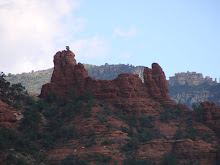Weird Western Tales
by Various
Vertigo Comics 2001
(Review originally posted on Feo Amante's Horror Thriller)
Vertigo proves that there’s more to Old West yarns than meets the eye with the six more stories of Weird Western Tales.
Copyright © DC Comics, Inc.
The cover of issue three by Fastner and Larson is the most humorous of the four issues. The expressions on the characters’ faces are priceless.
Scott Cunningham’s and Danijel Zezelj’s “Settlers” concerns a family who have been seeking gold for so long, the son doesn’t know any homestead but the open sky. The father stumbles upon a claim being mined by “Indians” of a tribe never before encountered, and his attempt to jump it. A bittersweet tale highlighted by Zezelji’s art which is reminiscent of Mike Mignola’s especially in his depiction of the “Indians” and their mining equipment.
“The Confession of Gabriel Winters” written by Nicholas Burns and beautifully illustrated by Doug Wheatley features a dying bounty hunter desperate to clear his notorious reputation by confessing to a priest. The atrocities Gabriel Winter has committed are brutal and many, and his belief that he has been blessed with this work is all the more appalling. Wheatley creates both horrific and tender imagery from a vulture-eaten corpse to a tearful eyed child. Burns’ dialogue was so well-written, I could hear the desperation in Gabriel’s voice and the disgust in the priest’s.
The setting is October 1963 in Texas in “Once Upon a Time in the Future” by Brett Lewis and Eduardo Risso. For more than one-hundred years the Union and Confederate States of America have maintained a bitter cease-fire between them. A flaming red-haired female marshal who hasn’t aged since the war began is working behind enemy lines on a secret mission. This is by far the weirdest of the weird westerns in this series. Lewis’ ambiguous story is intriguing nonetheless and Risso illustrated a unique desolate environment. I would like to see this story continue.
Copyright © DC Comics, Inc.
On the cover of issue four is a gambler caught cheating. This is a fun design by Jordi Bernet and colored by Mark Chiarello.
Owen is a browbeaten husband in Peter Milligan’s and Duncan Fegredo’s “What a Man’s Gotta Do.” A fan of the Duke, Clint, Coop, Shane, and other mythic Hollywood cowboys, Owen decides he’s not going to take it anymore and recapture man’s true pioneering spirit. He dresses up in cowboy gear and fights back against his female oppressors—his wife and boss. But he’s not the only male looking to find his roots. Milligan’s story is hilarious and Fegredo perfectly captures Owen’s transformation from henpecked husband to trail boss.
“Savaged” is the harshest tale in this issue. Bruce Jones’ story follows a homesteader’s degradation as his family is captured by a Cree tribe. The chief takes his wife and son as his own, and he is relegated to a camp joke—feeding with dogs and sharing a teepee with a large woman who beats him. The years of abuse take their toll, but he never surrenders hope for revenge. Cully Hammer provides comic and terrifying illustrations in rendering the homesteader’s humiliation and making the reader feel both sympathy and fear for him. Sherilyn Van Valkenburgh deserves mention for her use of color throughout—fiery orange and reds as the Cree attempt to destroy the homesteader to cool blues and blacks as he takes back his dignity.
Ending the series on a light note is “Bury Me Not on the Lone Prairie” written by Jen Van Meter and illustrated by Dave Taylor. Three cowboys transporting cattle—and their dead friend—to market discover its not easy keeping a body from falling prey to various natural and unnatural hazards. Van Meter keeps you smiling as you travel alongside these cowpokes, but manages to slap you in the face by the end. Taylor’s vistas that the cowboys travel through are particularly good.
These last two issues of Weird Western Tales equal the first in quality.






